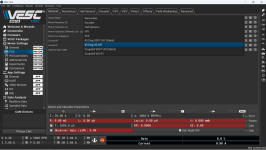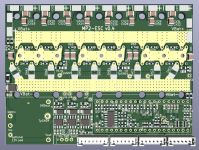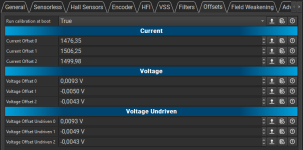Hello to everyone,
I'd like to give some feedbacks/comments/questions about this project and anything related. So far, this project out of any I've seen is outstanding. Compared to any esc repositories, this is truly open source and a beast. It is unlike what ennoid has done, claiming that the gen 1 bms is open source when in reality the actual pcb files aren't available and let alone the schematic files are corrupted and missing major battery and load terminals. Haven't seen that at all here. Speaking of a bms, does anyone recommend a good bms I could order at jlcpcb given the design files for a 100.8v 300 amp maximum setup? That would be very great. I'm basically going to use this esc for a bicycle to convert it into an ebike. I'll see how it performs and will give feedbacks and recommendations as well as updates.
Moreover, there are so far some improvements that could be made if I am not wrong. I adjusted some designs to the board due to the fact that badgineer greatfully pointed out the high cances of arcing which I was scared of. I initially tried to make the board larger but it seemed tedious and also since I am kind of a beginner at KiCad. But with some YouTube tutorials, I managed to make some modifications. For aesthetic reasons, I slightly crammed the holes of the phase wires within the phase contact areas which may probably also reduce arcing. I also added a total of 4 bus bar mounting holes, 2 each for each of the battery terminals. At first, I thought this was a stupid idea. This was because they intersected the bottom mosfets and I would have to mount the FETs vertically which would give worse cooling and probably an explosion. But fortunately, I could just use a nut for each hole mounted on the bottom of the board and then just bend the mosfet over it (OBVIOUSLY I WILL PUT INSULATION ON THE NUTS.) In case it was a bad idea, I attached the project files as a ZIP to this post AND since I love open source things so much that I would marry it (just kidding lol). I invested my own time and stayed up a couple of nights for this so hopefully my modified design to badgineer's ESC won't turn out to be a failure. To anyone on this thread, especially badgineer, it would be amazing if they could check the design files from this post and see if it is hazardous/dangerous/unfit for use at all as well as some recommendations.
Hi Dayanul,
Regarding open source - yeah, we did it all open, down into detail. Many open source projects also have commercial "sister projects" - so there is a motivation behind not giving out everything. That's not true in this case, MP2 is probably useless commercially. (tedious to assemble, pill based, etc)
Its more of a learning (or teaching) device.
We also really invested time in the readme/documentation, especially
@owhite, I recommend everybody to read that.
Regarding arcing: The arcs don't start spontaneously because of some major design flaw, we just had 1 accident once. As a result, we did quite a few improvements to make starting arcs harder in v0.4. At least I like to think its better now.
If you want to start modifying something, maybe start from v0.4. there's quite some extra work that went in it, compared to.
Also, If you don't *really* know what you are doing, don't go overboard with the modifications, at this time most of the things are designed as they are for good reasons

.
Example: if you put bolts under the mosfets, you'll have to mount the mosfets further from the PCB. and at high current, the thin legs of the mosfets are a bottleneck and heat up quite a lot. Also they're inductive and make switching less clean. If you want to go over say 150A, mosfets should be mounted as close to the PCB as possible, ideally the thick part of the mosfet legs should be touching the pads on the PCB.
Ill maybe look at your files later, have very little time these days.
PS: 100.8v 300 amp maximum setup? that's almost 40 horse power... I dont think the MP2 will be able to handle this kind of power for more than ...a few seconds.
Just trying to set expectations, so you wont be disappointed later

Br,





